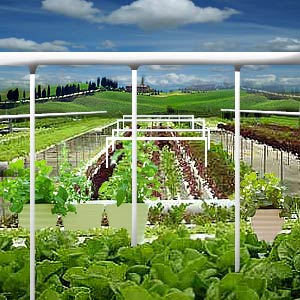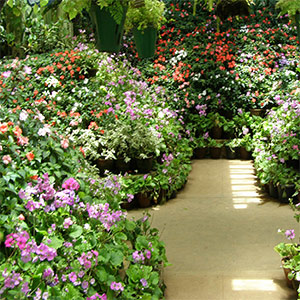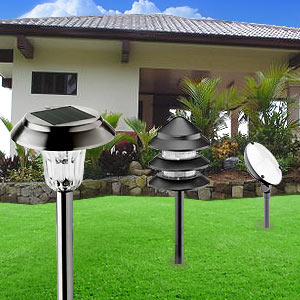Hydroponics Gardening

Growing plants without soil might sound amazing and people might wonder if it is ever possible. Hydroponics is one such method to grow plants without soil. Hydroponics is believed to improve the yield of certain terrestrial plants when compared to the yield while they are grown in soil. This system of growing plants has been around for the more than thousands of years. Vegetables or fruits grown from this system are hygienic, healthy and fresh.
Terrestrial plants can be grown without difficulty if their roots are immersed in a mineral nutrient solution, the roots can also be immersed in an inert medium like mineral wool, gravel and perlite. Outstanding examples for hydroponics are the floating gardens of China and the hanging gardens of Babylon. Countries like Holland, Australia, and Germany have been utilizing hydroponics to grow plants and have benefited a lot from it. Learn more about hydroponics gardening.
What is hydroponics ?
Hydroponics is coined from the Greek words, hydro meaning water and ponics meaning labor. Hydroponics gardening is a method of growing plants without using soil. In the 19th century plant physiologists discovered that plants take in their vital mineral nutrients from water in the form of inorganic ions.
In general the soil is considered as the mineral nutrient for any plant. The essential mineral nutrients from the soil dissolve in water and permit the plant to absorb these nutrients. In hydroponics gardening, mineral nutrients required for a plant to grow can be directly introduced to the water thus eliminating the need for soil. Almost all terrestrial plants can be grown using hydroponics. You can either buy a readymade hydroponics system or build a system on your own. Readymade hydroponics kit includes all the necessary things required to grow a plant.
Hydroponics kit
- Growing tray
- Growing medium
- Mineral nutrients
- Growing system
- Reservoir
- Watering equipment
- Sufficient light
Hydroponics growing mediums
Growing mediums are mainly used to ventilate and support the root system of the plant; they also act as a guide for the nutrients and water. Medium to grow plants is chosen as per the specific requirements. Popular mediums used in hydroponics are:
Rockwool: Rockwool used for growing plants is specially made to suit horticulture purposes. It is made from volcanic rocks and limestone. Rockwool is used as a growing medium because it can retain more water when compared to soil; it can hold 20% more air when compared to soil. While using rockwool as medium, the pH level in the nutrient solution has to be checked often as rockwool has high pH content by itself.
Hydroton:
This type of medium is light and has plenty of air circulation when compared to other media. The airiness of this medium allows a lot of oxygen to enter the plant's root system. Hydroton grow rocks can be used for a long period and do not interfere with the pH level of the nutrient solution.
Sand, perlite, vermiculite:
Other types of frequently used growing mediums are perlite, sand of varying grades and vermiculite. These growing mediums do not interfere with the pH level of the nutrient solution and are safe. These mediums retain too much moisture; therefore plants that require high level of moisture to grow must be grown in these mediums.
Hydroponics systems
Hydroponics system can be classified into active system or passive system. In the active system, a pump is used to circulate the nutrients. In a passive system the system is dependant on the capillary action of the wick or the growing medium. The nutrients are absorbed by the medium or the wick and are sent to the root. Passive systems are normally wetter than desired and as a result reduce the oxygen supply to the roots thereby affecting the overall growth of the plant.
Continuous drip system:
This system is an active recovery or non-recovery type of system. A submersible pump along with a reservoir is used in this type of system; all the plants are connected to the supply lines. A drip emitter is used to regulate the amount of solution for each plant as per requirements. A drip tray is used below every row of plants, re-routing the nutrient solution to the reservoir. This type of nutrient solution transfer makes this system an active recovery system.
The ebb and flow system:
This is an active recovery type system. The plants are placed in the upper tray, a reservoir and submersible pump is used in this system. The reservoir is used to hold the nutrient solution. The moment the pump is switched on, the nutrient solution is pumped to the upper tray thus delivering the solution to the plant roots. The pump can be kept functional for about thirty minutes; this period is called the flood cycle.
After the desired water level is achieved, the excess solution is drained back into the reservoir through the overflow pipe. This system provides ample oxygen supply to the roots during the flood cycle; poor oxygen is thrown out and fresh oxygen is sucked in. Grow rocks or rockwool is the commonly used growing medium for this system. Minimal maintenance but greater yield is the secret of this system.
The wick system:
This is a passive non-recovery type of hydroponics system. No moving parts or pump is used in this system. A candle or lantern wick employs capillary motion to circulate the mineral nutrients to the plant roots. The mineral nutrients are stored in a reservoir. The growing medium in this system is perlite, sand, or vermiculite mix. This is an economical hydroponics system and is easy to maintain. This system keeps the growing medium wet throughout thus reducing oxygen supply to the roots, hence is considered as a not too effective system in hydroponics.
Nutrient film technique:
Also known as the NFT, this system is an active recovery type hydroponics system. This system is an effective method of growing plants. A reservoir and a submersible pump to the pump the nutrients solution is used, the nutrients solution is pumped into a grow- tube. Roots of the plant are suspended in this tube and the roots receive a constant supply of the nutrient solution. For oxygen supply, air stones or capillary matting is used. No growing medium is used to grow plants through this system. The plants are offered support by a grow basket or support collar.
Desired pH for hydroponics system
Checking the pH level in a hydroponics system is much simpler checking in soil. The pH value for hydroponics systems can vary from 5.8 to 6.8, though the desired level is 6.3. Testing kits to check pH levels are available in hydroponics, pet, or hardware stores; they are priced between US$4 and US$15. Meter to read pH is also available in the market and it costs about US$ 100, these meters provide a digital reading after measuring the pH levels in the system. Checking the pH level in hydroponics system is very important as too little or too high pH can harm the plant growth. Remember to check the pH levels once a week. Add potash as required for increasing the pH levels and add phosphoric acid to lower the pH levels.
Nutrients for hydroponics system
Nutrients used for hydroponics systems have the same elements that a soil fertilizer would have. Hydroponics nutrients are available in liquid and powder forms and are available at hydroponics stores. They are concentrated mixes and are available as two separate containers - one is used during the growing period and the other during the blooming period. Organic and chemical nutrients can also be used but care should be taken that they do not clog and block the pumps. The secret behind the success of hydroponics gardening lies in the nutrients being used, hence choosing the right nutrients brings out the best yield in each plant.
Benefits of hydroponics
- A plant grown in this system grows 30-50 % faster when compared to plants grown under similar conditions in soil.
- Yield of the plant improves drastically.
- Hydroponics gardening requires barely 20% space required of soil gardens for an equal yielding capacity.
- Hydroponics growth medium has excess oxygen when compared to soil medium thus promoting plant health and root growth.
- The root system has adequate oxygen thus they are able to absorb more mineral nutrients.
- The plant gets it mineral nutrients straight from the water. This saves the plant's energy thus promoting the yield and the overall growth of the plant.
- Hydroponics plants are healthier when compared to soil plants as they are not affected by any diseases.
Why choose hydroponics ?
- Plants can be grown without a backyard or garden.
- Plants can be grown with ease even indoors.
- Yield is better when compared to soil gardening.
- You can grow plants throughout the year immaterial of the season.
- The mess of weeding, no digging and frequent watering is avoided.
Top of the Page: Hydroponics Gardening
Tags:#hydroponics gardening

Eco Friendly Homes
Garden Maintenance
Organic Gardening
Vegetable Garden Layout
Xeriscaping
Hydroponics Gardening
Feng Shui Garden
Ornamental Plant
Container Garden
Growing Succulents Indoors
Landscape Design Idea
Herb Garden Design
Window Garden
Lawn Mowing
Lawn Maintenance Tips
Orchid Care
Bonsai Tree
Cactus Plant
Thanksgiving Cactus
Rock Garden
Gardening Accessories

Bird Feeder
Leaf Blower
Solar Bird Bath
Lawn Sprinkler System
Outdoor Garden Furniture
Garden Fountain
Butterfly Garden
Electric Lawn Mower
Garden Pond
Landscaping

Landscaping
Landscape Lighting
Outdoor Canopy
Solar Garden Lights
Garage Plan
Home Improvement
Home Furnishing
Home Improvement Catalog
Feng Shui
Top of the Page: Hydroponics Gardening
Popularity Index: 101,389

